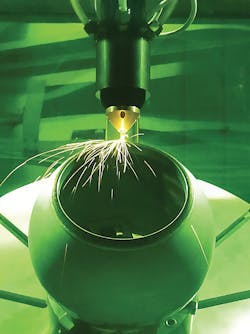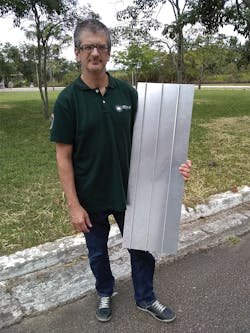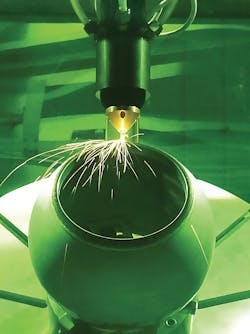Industrial laser system sales grow over 2016 results
MILTON S. F. LIMA
In general terms, Brazil occupies a moderately relevant position within the so-called Brazil, Russia, India, and China (BRIC) region, although it has an enormous potential for domestic consumption. China clearly has an international relevance in the export of manufactured goods of low and medium technological intensity, while Russia stands out as an exporter of medium and high technology goods.
However, in regional terms, Brazil is the economic power of Latin America, concentrating 55% of the gross domestic product (GDP) of all the countries of the region. Knowing this fact, almost all companies supplying industrial lasers and integrated laser systems have their South American headquarters in Brazilian territory. This is the case for the leading companies in the supply of laser solutions in Latin America—TRUMPF and IPG Photonics, both with offices in the city of São Paulo.
Main players
The Brazilian market for laser equipment has gone through nearly a decade of stagnation due to the mistaken actions of the federal government, which has been reflected in the sale of lasers and integrated systems until the beginning of this year. According to John Visetti, CEO of TRUMPF Brazil, the worst has already passed, and the company sold twice the number of laser systems from January to June 2017 compared to the same period of 2016. The main product is its TruDisk system for laser cutting in the automotive and agribusiness sectors. Its clients have received fully integrated solutions with a lot of Internet capabilities and cloud storage possibilities. According to Visetti, the consultations for new equipment for the next 6–12 months indicates a prosperous 2018.
Brazilian IPG Photonics is also very happy with their numbers. Similar to TRUMPF, IPG Photonics opened an R&D center and job shop in São Paulo.
Industrial activity in Brazil is concentrated in the southeastern and southern regions of the country, and consequently the vast majority of industrial laser systems are found in these regions. In the case of laser cutting service for sheet metals (FIGURE 1), a 2009 general guide presents 37 companies in the state of São Paulo and 27 in other states. However, a recent visit revealed that these numbers can be easily doubled, remaining conservative in both magnitude and regional distribution. There are about 180 modern high-power laser systems in operation in the southern region of the country.
FIGURE 1. The Institute for Advanced Studies’ laser labs specializes in machining custom stiffened panels, such as this aluminum alloy skin.
Companies that perform laser cutting services generally include other processes such as mechanical forming, machining, surface protection, or painting. This is not the case in laser marking and engraving, because they deal directly with products in the final state. There are about 60 laser marking and engraving companies only in the metro region of São Paulo.
As expected, the automotive industry is the driving force behind several mechanical transformation industries in the country. This happens even after a long period of stagnation, during which the country fell from the fifth position in 2013 to the ninth in 2015 in the number of cars manufactured in the world. The competitiveness of the sector was shaken by the growing stock of the automakers and was reflected in the quality and safety of the cars sold in the country.
The laser is utilized in two places in automotive manufacturing—cutting of blanks or stamped parts and welding of these blanks. However, only two carmakers apply this concept in the body-in-white for the assembly of the body. There is also a possibility for laser cutting prior to hot stamping of advanced high-strength steels. In Brazil. These steels are sold by CSN, Usiminas, and ArcelorMittal, among others. Laser cutting of hardened materials—for example, martensitic steel—with minimal kerf and high speed attracted many fans of the automotive industry.
Several remote welding systems are available in Brazil, the pioneer being the Fiat plant that uses a Comau system with a 3 kW IPG laser. The system was dedicated to the welding of doors and pillars in partial replacement to resistance spot welding (RSW).
The use of aluminum in automotive construction remains an open question, since electricity in Brazil is relatively expensive and its price varies widely during the year. There is still no detailed study of the impact of automotive aluminum construction on the national scene, and whether the laser will provide a gain in productivity compared to arc welding, RSW, or adhesive bonding. Local and domestic energy for the electric cars may change this scenario in the near future, using cheaper electricity from hydroelectric plants in the Brazilian system.
Although the bulk of the high-power lasers in the Brazil market is supplied by two large companies, there are some niche applications that smaller companies are servicing. A good slice of the laser equipment sold under these conditions is equipment of Asian origin, sometimes with a Brazilian skin to reduce the taxation of the imported ones.
Manufacturing activity
Imported Chinese products, including Class IV lasers, are abundantly available in the Brazilian market. Excluding Chinese products, most of the lasers in operation in Brazil come from the U.S., Germany, or Japan, with a small slice from France, Italy, Czech Republic, and the UK. Research involving Class IV lasers has a more balanced distribution among international suppliers, as they rely heavily on the experience of the researcher responsible for their use abroad.
There is a paradigm shift in the industries of the country’s south-southeast macro-region focused on the domestic market, to refocus on the external market. About two-thirds of the products with medium and high technological intensity are exported according to the strict criteria of the European Community and the U.S.
The industrial lasers in installation are maintenance-free. There is a steady market for what lies outside the optical cavity, including high-power optics, sensors and actuators, automation, and equipment integration for the digital economy.
However, with the main players consulted in the manufacturing industry, there appears to be no predisposition for radical change in the industry. With a wide, diversified, and skilled workforce, Brazil has the means to implement factory floor routines that are closer to the assembly of iPhones than the German autonomous factories. The gradual change of the labor statutes points to a favorable environment for the intensification of the use of labor, and returns to the model of outsourcing of secondary activities in the industry.
In heavy industry, the laser already competes with plasma cutting of thick plates, particularly in the investment project of the naval industry, although there have been no effective purchases of units with power exceeding 10 kW. Nevertheless, there is a revitalization movement of the naval sector in the city of Rio de Janeiro and major projects underway, such as the development of a submarine shipyard in conjunction with France.
FIGURE 2. SENAI (ISI Laser) additive manufacturing equipment in action is shown.
The industrial sector is looking for solutions in additive manufacturing (FIGURE 2), particularly in molds and dies and repairs in general. Brazilian ROMI Co. has recently developed a five-axis computer numerical control (CNC) system with a 3D head for additive manufacturing. In the same vein, several startups and small and medium-sized companies are acquiring powder beam fusion (PBF) or direct energy deposition (DED) technology for specific application niches such as implants, molds, electrodes, and design.
One must keep their eyes open for the technological needs of very large cities such as those in Latin America. The Rapid Transit to Residence (RTR) indicator of urban mobility shows a clear saturation in the efficiency of individual transportation in Brazilian capitals, demonstrating that this model is unsustainable. Modern, efficient, and non-polluting means of shared transportation are the only possible option in cities such as São Paulo and Rio de Janeiro. This indicates a number of technological changes that may be opportunities in photonic manufacturing, including products such as batteries and advanced embedded sensors.
Brazil resists modern legislation on the use of lasers, including certification and approval of new sources, as well as those related to operator health. The Brazilian standard in use, NR-12 Safety at Work in Machinery and Equipment, does not include basic safety information for lasers. Thus, the standards used are generally American and employed without proper training. There is a wide field in training and qualifying people in laser technology. More than half of the class III and IV laser maintenance officers are inadequately or trained, and in need of urgent update. It is important to prevent laser accidents because society opinion, through social networking, is eager to judge without hesitation, as has occurred in the case of nuclear power plants.
Conclusion
The degree of innovation and inventiveness of Brazilians is remarkable, even in times of economic crisis and political turbulence. There are about 1.5 million micro-entrepreneurs scattered throughout the country, many of them linked in some way to the digital economy. New businesses are opening at a rate never seen before. In addition, considering the pleasant nature of our people, Brazil is the right destination to start new commercial partnerships.
DR. MILTON S. F. LIMA ([email protected]) is responsible for the laser processing labs at Institute for Advanced Studies in Sao Jose dos Campos, Brazil, and is an Editorial Advisor for Industrial Laser Solutions.



